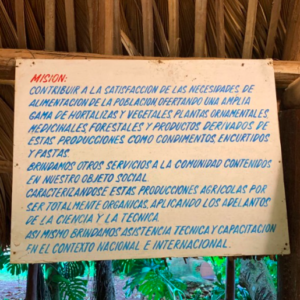After the Grupo de Agricultura Orgánica in Cuba was given the Right Livelihood Award (also called the Alternative Nobel Prize) in 1999 my wife Amanda Haworth and I decided to go to Cuba and see what was going on. We met with a representative from the Ministry of Agriculture in Havana and learned about the total catastrophe that broke out after the collapse of the Soviet empire and how it was solved.

The reason to look at Cuba has to do with the fact that we are now facing the necessity of a deep adaptation due to climate change and loss of biodiversity. Cuba managed a turnaround from total collapse to feeding its population within a couple of years. It is as far I know the only example when a whole nation has made an adaptation to a catastrophic situation and come out the other end, hurt but having managed to reform its entire agricultural system.
In a situation where we need to have good examples and understand what an adaption to what is coming really means Cuba serves as a role model and an example of what is possible. Although in their case the crisis was even worse as it happened overnight.
For those who don’t know this part of Cuba’s history the country imported 90 % of fertilizers and pesticides for their large scale farming industry. When imports from the socialist bloc collapsed in 1990 these imports dropped by 77 and 60% respectively. Food import dropped by 50% and the import of fossil fuel by the same percentage. The industrial farming system, similar to the one in the US, was now faced with the problem of doubling the food production while at the same time keeping up food export to earn dollars but lacking the necessary inputs. Due to the US trade ban Cuba could not get help from the outside. It was an impossible equation.
The solution was organic and semi organic farming and that’s why they were awarded the alternative Nobel Prize. What helped them was the educational system with more per capita scientists than any other Latin American country. Some had already been studying organic farming. Now, they mobilised these resources, scientists were sent out to rural areas in turn mobilising groups of farmers who learned about bio-pesticides and bio-fertilizers. State owned land was split up and small farms and cooperatives were formed, they organised workshops were farmers shared good and bad examples, slaughtering horses was prohibited as they had to replace tractors, hundreds of thousand of oxen were bred up for the same reason. Within a few years time, just as the first signs of malnutrition were showing and even risk of famine threatened, food production picked up and famine was averted.
Is this the end of story? Today, large parts of the farming system are back using conventional methods, but 20% is organic and growing. But the small farm system has been kept even though it is not the optimal production size, as they have realised that it improves resilience and gives other benefits such as stopping the flow of people from rural areas into cities, since more farm workers are needed.
Not only can we learn from Cuba’s experience, it also demonstrates that when needed it is possible to adapt to changing circumstances, and bring resources and people together to solve the crisis.

 Gästbloggare
Gästbloggare
